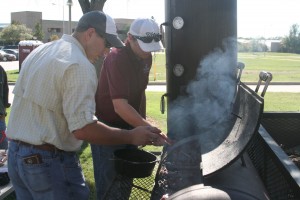 With barbecue, “low and slow” is often the description that best describes the cooking process. “Low and slow” is important because cuts such as briskets and pork butts are large and need to be cooked at lower temperatures (200 to 250°F) so that the outside portion does not get overcooked while waiting for the proper internal temperature of the middle of the cut to be reached. Barbecuing large cuts of meat over lower temperatures obviously results in long cooking times. Many of the guidelines for barbecuing these large cuts will use the guideline of one hour of cooking per pound of raw cut.
With barbecue, “low and slow” is often the description that best describes the cooking process. “Low and slow” is important because cuts such as briskets and pork butts are large and need to be cooked at lower temperatures (200 to 250°F) so that the outside portion does not get overcooked while waiting for the proper internal temperature of the middle of the cut to be reached. Barbecuing large cuts of meat over lower temperatures obviously results in long cooking times. Many of the guidelines for barbecuing these large cuts will use the guideline of one hour of cooking per pound of raw cut.
Because low cook temperatures are used for barbecuing, indirect methods of cookery are most often used. As the name implies, this method involves having the source of heat away from the meat so that the temperature range of 200-250°F can be more easily achieved.
 Smoking is an important part of barbecuing. In Texas, the four principal woods used to cook with are hickory, oak, pecan, and mesquite. Everyone has an opinion about which wood they like to use, and individual preference is often based on what people grew up eating. For the most part, regional preferences developed more than anything on local availability of the woods.
Smoking is an important part of barbecuing. In Texas, the four principal woods used to cook with are hickory, oak, pecan, and mesquite. Everyone has an opinion about which wood they like to use, and individual preference is often based on what people grew up eating. For the most part, regional preferences developed more than anything on local availability of the woods.
Today, there are a wide variety of wood, wood chunks, and wood chips that can be used to impart the smoke flavor on barbecue. Getting the correct amount of smoke on barbecue is important because too little smoke flavor is not satisfying and too much results in the smoke overpowering the meat. Remember that smoking complements the meat so work to achieve the correct amount when barbecuing.
Here’s a compilation of links that provide more insight, tips, techniques and instruction on cooking and smoking:


